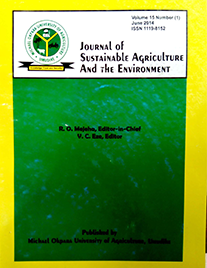The Evaluation of the Nutrient Composition and Anti-nutritional Factors of Jackfruit (Artocapus heterophyllus)
Main Article Content
Abstract
The objective of the study was to determine the chemical composition of Jackfruit (Artocarpus heterophyllus). Ready to eat jack fruits were harvested from the garden of Forestry Department, Michael Okpara University of Agriculture Umudike. The fruit was identified taxonomically by the Head of the Department of Forestry. Standard methods were used to evaluate the chemical constituents of the fruit (pulp and seed). The moisture content of the pulp (89.5g/100g) was significantly (p<0.05) higher than that of the seed (10.3g/100g) but the crude protein, crude fat, crude fiber, ash and carbohydrate of the seed (16.3, 5.3, 4.3, 5.3, 58.4g/100g) were however significantly (p<0.05) higher than those of pulp (3.3, 0.76, 1.1, 1.1, 4.3g/100g). The calcium and magnesium contents of the pulp were 19.3 and 29.6mg/100g while those of the seed were 40.6 and 53.8mg/100g. The vitamins A and C contents of the pulp (294.8µg/100g, 27.6mg/100g) were significantly (p<0.05) higher than those of the seed (145µg/100g, 12.9mg/100g). The oxalate, phytate, alkaloid, saponin, flavonoid content of the seed were 129,109, 164, 78,139mg/100g while those of pulp were 41, 18, 33, 17, 23mg/100g. The nutrient compositions of jack fruit were comparable to those of most common fruits. Jackfruit seed was found to be richer in carbohydrate, crude protein, fat, fiber, ash and in all the minerals studied than the pulp, while the pulp was richer in vitamins A, C, E, and the B vitamins (B1, B2, B3, folic acid).
Article Details
References
Anigo, K. M., Ameh, D. A. Ibrahim, S and Danbauch, S. (2010). Nutrient composition of commonly used complementary foods in North western Nigeria. Afri. J. n-Biotech 8(17): 4211-4216.
AOAC. (2006). Official Methods of Analysis. Association of Official Analytical Chemistry, Washington D.C.2006.
Bobbio, F. D., El-Dash, A .A., Bobbio P. A., and Rodriguies, L. R. (1978). Isolation and characterization of the physico-chemical properties of starch of jackfruit seeds (Artocarpus heterophyllus). Cereal Chem.,55: 505-511.
Bowman, B.A., and Russell, R.M. (2001). Present knowledge in Nutrition 8th edition. ILSI press Washington DC.
Burkill, H.M., (1997). The Useful Plants of West Tropical Africa. Vol. 4, 2nd Edn. Royal Botanic Gardens, Kew,pp: 160-161.
Chowdhury, A.R., Bhattacharyya, A.K., and Chattopadhyay, P. (2012). Study on the functional properties of raw and blended jackfruit seed flour (a non-conventional source) for food application. Indian Journal of Nutritional products and Resources. Vol.3 (3). Pp 347 – 353.
Eke-Ejiofor. J. and Owuno. F. (2013). The physico-chemical and sensory properties of jackfruit (Artocarpus heterophilus) jam. Int’l J. Nutr. Fd. Sci. 2: 149-152
Ene- Obong, H.N.(2001). Eating – Right. Calabar University Press. P. 24-27.
Gupta. D., Mann, S., Sood, A., and Gupta, R.k. (2011). Phytochemical, Nutritional and antioxidant activity Evaluation of seeds of Jackfruit (Artocarpus heterophyllus LAM). International Journal of Pharma and Biosciences. Vol 2 (4). P336-345.
Harborne, J. B. (1973). Phytochemical Methods,Chapman and Hall, London. Pp 110-113.
Haq, N. (2006). Jackfruit: Artocarpus heterophyllus. Southampton, UK: Southmpton Centre for underutilized crops. P.129. ISBN 0854327851. http://ndb.nal.usda.gov/ndb/search.
Haque, M.A. (2010). Jackfruit: Botany, Production Technology and Research in Bangladesh. Jahanara Haque Publisher, 291, Dhaka Road, Mymensingh. P. 143.
Hossain, M.M., Mahmud, A.A., Kabir, T.H., Dhar, M. and Ahmed, K.U. (2011). Nutritive value and processing of jackfruit. Proceedings of the national workshop on jackfruit problem, prospects, research activities and development in Bangladesh, held on 02 March 2011 at BARC, Farmgate, Dhaka, Bangladesh.
Kirk, R.S., Sawyer, R. (1991). Pearson’ composition and analysis of foods (9th edition) Longman Group Ltd UK.
Layrisse, M., Garcia-Casal, M.N., Solano, L. (1998). Vitamin A reduces the inhibition of iron absortion by phytates and polyphenols. Food Nutr Bull. 19: 61 - 67.
Makkar, H.P.S., and Becker, K. (1996). Nutritional value and antinutritional component of whole and ethanol extracted Moringa oleifera leaves. Animal Feed Sci. Technol. 63:211-238.
McCarron, D.A., Reusser, M.A. (1999). Finding consensus in the dietary calcium- blood pressure debate. J. Am. Coll Nutr. 18: 398S-405S.
Morton, J. (1987). Fruits of Warm Climates. Miami, Florida.
Rahman, M. A., Nahar, N., Mian, A. J. and Mosihuzzaman,M. (1999). Variation of carbohydrate composition of two forms of fruit from jack tree(Artocarpus heterophyllus L) with maturity and climatic conditions. Food Chem., 65: 91-97.
Samaddar, H. M. (1985). Jackfruit. In: T. K. Bose, and S. K. Mishra (eds.), Fruits of India: tropical and subtropical. Naya Prokash/Calcutta, India. pp. 638-649.
Stadimaryr, B., Nilson, E., Mouille, B., Medhammar, E., Burlingame, B., and Charrondiere, R. (2010). Nutrition indicator for Biodiversity on food composition. A report on the projects of data availability. FAO Rome Italy.

